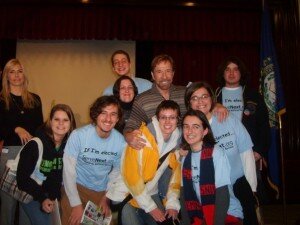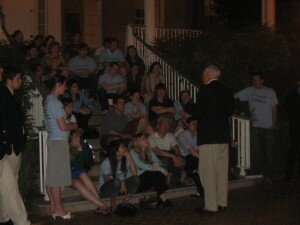Do you want to create high-impact, well-managed community projects that make a meaningful difference and engage neighbors and residents?
 If so, HandsOn Network would call you a volunteer leader, someone who sees a local need and takes the initiative to find a solution.
If so, HandsOn Network would call you a volunteer leader, someone who sees a local need and takes the initiative to find a solution.
(We love you guys!)
Okay… you’ve identified a need in your community and you want to to meet that need, what’s next?
Step One: Identify Nonprofit or Neighborhood Partners
 Contact the appropriate local nonprofit or community organization to introduce yourself and your idea.
Contact the appropriate local nonprofit or community organization to introduce yourself and your idea.
For example, if you want to organize a project to capture the oral histories of local seniors you may decide to work with a local senior center.
Similarly, if you want to restore a local stream bank, you may need to work with the local department of parks and recreation and /or the local neighborhood association.
Schedule a meeting to discuss your project idea and determine the next steps.
Ask what other stakeholders should be consulted and involved.
If you’re working in a community, strongly consider holding a meeting to discuss your idea with residents and be sure to incorporate their leadership, ideas and support.
Step Two: Initial Site Visit
Work with your partners in advance to plan the project.
Determine what date(s) and time(s) you will hold the project and begin to develop an understanding of how you will manage it either on the day of the event or from one session to the next.
On your way to the site, take note of any odd driving directions. Providing this information will keep your volunteers from getting lost on their way to the project.
During the site visit, ask questions that help you understand the agency or neighborhood’s greatest needs and the ways that your one-time or ongoing volunteer support can have the greatest impact.
Consider using the HandsOn Project Work Scope Planner to break your project down into tasks, estimate the number of people needed for each one, the amount of time each will take and estimate the materials needed.
Carefully consider the types and amounts of materials you’ll need to complete each of the project tasks so that your volunteers will have what they need when they show up to help and you can make the best use of their gift of time.
Brainstorm with your agency partner about how to secure the needed tools and materials.
Can the agency provide them?
Can you ask volunteers to bring tools from home to support the project?
Can you work together to solicit the support of local businesses?
Determine the type of participation that you can expect from the agency during both the planning phase and the project itself.
Will they have supervisors and potential agency / community volunteers to work with you at the project?
Make sure you exchange contact information and plan your next meeting and the next steps.
Step Three: Recruit Your Friends to Help
In order to lead a great one-time or ongoing service project you’ll need volunteers!
It is important to develop a volunteer recruitment strategy to ensure a successful project.
If you have too few participants, the project will likely go unfinished, but too many will likely mean that some will have little to do and might feel that their time was ill spent.
To prevent this, consider organizing a volunteer registration process.
This can be as simple as you keeping a list or spreadsheet of the names and contact information for those that signed up.
Alternatively, you can experiment with online tools such as or Volunteer Spot.
Pre-registering volunteers also enables you to talk with interested volunteers about the skills, supplies or friends they might be able to bring to the project.
If your project is small, you may be able to both organize the project and recruit the volunteers.
However, if your project is large, requiring many volunteers, you might really benefit by identifying an individual who would be willing to lead volunteer recruitment for you.
Consider recruiting a volunteer to serve as The Official Chairperson of Volunteer Recruitment.
[Real leaders empower others, right?!!]
Here’s a long list of recruitment ideas.
Step Four: Advanced Preparation
Call your agency contact to review project details and confirm logistics.
Arrange for the agency or neighborhood representative to prepare a brief presentation thanking your volunteers for coming and explaining how their time will contribute to the overall cause.
Schedule a final site inspection if necessary.
Pick up any tools and materials that have been donated or arrange to have tools picked up and delivered to the project site.
Make sure all tools and materials are at the site, in your possession (in the trunk of your car!) or otherwise immediately available.
Make any final calls to landscapers, gardeners, painters or other specialists you have recruited.
Think through contingency plans for inclement weather, too many or too few volunteers showing up on the day of the project and any other potential problems you can anticipate.
Confirm event logistics and details with volunteers.
Strategize about how you will manage your volunteers at the project. How will you make it such a great experience that volunteers return again and again?
Consider planning a group discussion at the end of your project, structured time for volunteers to think and talk about what occurred during the project.
This group conversation can often deepen volunteers understanding of the social issue your project addressed and increase their commitment to service.
 Step Five: Manage the Project
Step Five: Manage the Project
- Arrive at your project site 30 minutes to one hour early to set up.
- Have all tools and materials ready and waiting at the location where a particular task will take place.
- Have all volunteers sign an attendance sheet and put on a name tag (including yourself).
- Have an agency / school representative speak to volunteers about the school or agency, their mission, their struggles, the difference volunteer efforts will make, thoughts on safety and any other announcements.
- Be a leader:
a. Know your outcome and convey it to your volunteers.
b. Be organized and assign / delegate work to your volunteers.
c. Keep the work moving on schedule.
d. Have fun and encourage volunteers to do likewise.
e. Give positive reinforcement.
- Be a public relations agent for your project with volunteers, agency reps. and interested community members.
- Bring a camera and take pictures.
- Be sure to start clean up efforts at least 30 minutes before the scheduled end of the project.
- Hold a group discussion before volunteers leave.
- Have volunteers complete an evaluation form before they leave the project site. This will help you and your agency partner evaluate what went well and what you might improve next time.
- Leave the site clean and in a “finished” state.
- CELEBRATE!
What additional suggestions do you have?
 Yesterday’s post introduced the idea of neighboring. It’s a place-based approach to community problem solving that focuses on individuals’ talents as a resource to improve their neighborhoods.
Yesterday’s post introduced the idea of neighboring. It’s a place-based approach to community problem solving that focuses on individuals’ talents as a resource to improve their neighborhoods.
 By Zach Maurin, Co-founder and Executive Director of
By Zach Maurin, Co-founder and Executive Director of  Field Corps will recruit, train, and support an annual cohort of community organizers to build and lead local networks.
Field Corps will recruit, train, and support an annual cohort of community organizers to build and lead local networks.

 To illustrate this point, the article resurfaces an old story of community impact.
To illustrate this point, the article resurfaces an old story of community impact.

 If so, HandsOn Network would call you a volunteer leader, someone who sees a local need and takes the initiative to find a solution.
If so, HandsOn Network would call you a volunteer leader, someone who sees a local need and takes the initiative to find a solution. Contact the appropriate local nonprofit or community organization to introduce yourself and your idea.
Contact the appropriate local nonprofit or community organization to introduce yourself and your idea.
 Step Five: Manage the Project
Step Five: Manage the Project
